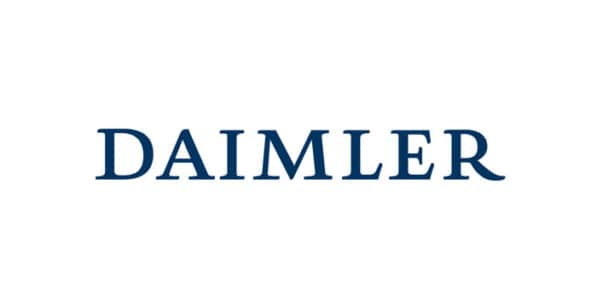STUTTGART, Germany — Daimler AG (DAI) reported on Feb. 11 its preliminary results for the fiscal year 2019 ended December 31, 2019. The Group’s total unit sales of 3.34 million passenger cars and commercial vehicles were in the magnitude of the previous year (2018: 3.35 million).
Revenue was €172.7 billion (2018: €167.4 billion), an increase of 3 percent. The Daimler Group posted full-year EBIT of €4.3 billion (2018: €11.1 billion), reflecting material adjustments, including expenses from legal proceedings and related measures, restructuring measures and M&A transactions. Adjusted EBIT, reflecting the underlying business, was €10.3 billion.
Ola Källenius, chairman of the Board of Management of Daimler AG and Mercedes-Benz AG: “While our results in 2019 reflect ongoing strong customer demand for our attractive products, we cannot be satisfied with our bottom line. Above all, material adjustments affected our financial results last year. The future of the Daimler Group lies in CO2-neutral mobility as well as in consistent digitization, leveraging its full potential in our products and our processes. To achieve that, we have substantially ramped up our investments into new technologies. We are determined to materialize our technological leadership and at the same time to significantly improve profitability. To this end, measures to cut costs and to increase cash flows are necessary. In 2019, we defined them and we have started executing. We will take the necessary actions to enhance our financial strength as the basis for our future strategy.”
In 2019, net profit weakened to €2.7 billion (2018: €7.6 billion). Net profit attributable to the shareholders of Daimler AG amounted to €2.4 billion (2018: €7.2 billion), leading to a decline in earnings per share to €2.22 (2018: €6.78).
At the Annual General Meeting on April 1, 2020, the Board of Management and the Supervisory Board will propose a dividend of €0.90 per share (2018: €3.25). The total payout will therefore amount to €1.0 billion (2018: €3.5 billion).
Investments, free cash flow and liquidity
At the Group, investments in property, plant and equipment decreased to €7.1 billion (2018: €7.5 billion). Research and development expenditure increased to €9.7 billion (2018: €9.1 billion). The free cash flow of the industrial business was €1.4 billion (2018: €2.9 billion). The sharp decrease resulted from a substantial cash outflow in connection with legal proceedings relating to diesel vehicles.
Also, a continued high level of expenses for new products and technologies had a negative effect. The net liquidity of the industrial business stabilized at €11.0 billion (2018: €16.3 billion), taking into account lessee accounting in accordance with IFRS 16 and the dividend payment for fiscal year 2018. The inclusion of lessee accounting in accordance with IFRS16 reduced the net liquidity of the industrial business from the end of 2018 to the beginning of 2019 by €3.2 billion.
Divisional results
Mercedes-Benz Cars sold 2,385,400 vehicles in the fiscal year 2019, and thus slightly topped the record level of the prior year (2018: 2,382,800). Mercedes-Benz Cars’ revenue increased to €93.9 billion (2018: €93.1 billion) and its EBIT fell by 53 percent to €3,359 million (2018: €7,216 million). Return on sales was 3.6 percent (2018: 7.8 percent).
A negative impact resulted from a new assessment of expenses for ongoing governmental and legal proceedings and measures relating to Mercedes-Benz diesel vehicles as well as expenses for a recall of Takata airbags. Growth in unit sales and revenue as well as better pricing were offset by continued high investment in new technologies and products. Adjusted EBIT was €5,841 million and adjusted return on sales was 6.2 percent.
Daimler Trucks showed a decrease in unit sales of 6 percent to 488,500 vehicles in the fiscal year (2018: 517,300). Revenue increased by 5 percent to €40.2 billion (2018: €38.3 billion). EBIT fell by 11 percent to €2,463 million (2018: €2,753 million) and return on sales was 6.1 percent (2018: 7.2 percent).
With continued strong business in NAFTA region, declines in volume, particularly in Europe and Asia, had a negative impact on earnings. Negative effects were also due to higher upfront expenditures for new technologies and costs related to capacity adjustments.
Mercedes-Benz Vans’ unit sales increased in the fiscal year 2019 by 4 percent to 438,400 (2018: 421,400) vehicles. Revenue was 9 percent higher at €14.8 billion (2018: €13.6 billion). EBIT decreased to minus €3,085 million (2018: plus €312 million) while return on sales fell to minus 20.8 percent (2018: plus 2.3 percent).
While the higher unit sales and a more favorable model mix had a positive impact on earnings, the division’s EBIT was crucially affected by a reassessment of expenses for ongoing governmental and legal proceedings and measures relating to Mercedes-Benz diesel vehicles as well as expenses for a recall of Takata airbags.
Furthermore, expenses for the review and prioritization of the product portfolio reduced EBIT. In 2019, measures were initiated to significantly improve the situation. Adjusted EBIT was €284 million and adjusted return on sales was 1.9 percent.
Daimler Buses’ sales grew by 6 percent to 32,600 units in the fiscal year 2019 (2018: 30,900). Revenue increased by 5 percent to €4.7 billion (2018: €4.5 billion). EBIT amounted to €283 million (2018: €265 million), an increase of 7 percent.
Return on sales was 6.0 percent (2018: 5.9 percent). The positive development was driven by the increase in unit sales in Brazil, among other things, as well as favorable exchange rate effects. In Europe, the battery-electric Mercedes-Benz eCitaro city bus is in series production at the plant in Mannheim and is being delivered to customers.
At Daimler Mobility, new business increased by 3 percent to €74.4 billion in the fiscal year 2019 (2018: €71.9 billion). Revenue was 9 percent higher at €28.6 billion (2018: €26.3 billion). The division’s EBIT amounted to €2,140 million (2018: €1,384 million), an increase of 55 percent compared to the prior year. At 15.3 percent, return on equity was above the figure of 11.1 percent in the prior year. A positive effect resulted from the merger of the mobility services of Daimler and BMW Group.
Furthermore, the higher volume of new business contributed to the EBIT increase. A higher equity ratio caused by tighter regulatory requirements had a negative impact. EBIT was also reduced by expenses relating to the realignment of the YOUR NOW group. Adjusted EBIT was €1,827 million and adjusted return on equity was 13.1 percent.
The workforce
At the end of the fiscal year, the Daimler Group employed 298,655 people worldwide (2018: 298,683), 173,813 people worked in Germany (2018: 174,663), 25,788 in the United States (2018: 26,310), and the consolidated subsidiaries in China employed 4,439 people (2018: 4,424).
Sustainable business strategy
Daimler faces the challenges posed by the transformation of the automotive industry with a sustainable business strategy. Demand for individual mobility and the worldwide transport of goods and people will continue to grow and will continue to form the basis for the core business as a vehicle manufacturer. The premium market for passenger cars will continue to grow sustainably and faster than the volume market in the future.
At the same time, Daimler is consistently committed to CO2-neutral mobility. In order to achieve the CO2 targets and to finance the important future fields of electric mobility and connectivity, enormous technical and financial efforts are required. The resulting costs require comprehensive measures to increase efficiency, streamline the company and increase the free cash flow.
Those measures include the significant reduction of material and administrative costs and the reduction of personnel costs by more than €1.4 billion by the end of 2022. The aim is to cut jobs worldwide in a socially responsible manner, including the reduction of management positions.
Daimler will continue its product and electrical offensive in the current year: To this end, Mercedes-Benz Cars is launching among others the new S-Class with the latest version of the MBUX multimedia system. The EQA will be the first fully electric SUV compact model to be launched this autumn. Mercedes-Benz Vans is expanding its product portfolio to include the all-electric EQV van.
In addition, the model range will also include numerous variants with plug-in hybrid drivetrain and 48-volt technology. Overall, Mercedes-Benz plans to quadruple the share of plug-in hybrids and fully electric vehicles in total sales in 2020. This is linked to a further increase in the company’s own battery production: Batteries for electric vehicles will be manufactured in nine plants at seven locations on three continents.
Outlook
Daimler expects Group unit sales in the fiscal year 2020 slightly below the prior-year level. Mercedes-Benz Cars, Mercedes-Benz Vans and Daimler Trucks assume a slight decrease in unit sales compared to the previous year. Daimler Buses sees slightly higher sales numbers. At Daimler Mobility new business should weaken slightly, while the contract volume should remain at the prior-year level.
Group revenue in the fiscal year 2020 is expected to be stable at the level of 2019. At Mercedes-Benz Cars & Vans, revenue should be around the prior-year level. Daimler Trucks & Buses expects a significant revenue decrease. The Daimler Mobility division forecasts revenue at the prior-year level. Daimler assumes that Group EBIT in 2020 will be significantly above the level of 2019, which was negatively impacted by various material adjustments.
The divisions have the following expectations for their returns in 2020:
— Mercedes-Benz Cars & Vans: adjusted return on sales of 4 percent to 5 percent,
— Daimler Trucks & Buses: adjusted return on sales of 5 percent,
— Daimler Mobility: adjusted return on equity of 12 percent.
Significant efficiency measures already initiated in all business areas, such as personnel and material cost savings, portfolio and model adjustments and the further implementation of platform strategies, as well as more stringent capital allocation, should have an initial positive impact on earnings as early as the 2020 fiscal year.
These measures will take full effect in subsequent years. Restructuring measures and the initiated job cuts, on the other hand, will have a negative impact on earnings in 2020. Daimler will continue to review all non-core activities in order to focus the financial resources on the businesses with the highest economic potential.
High upfront investments for new products and technologies will continue to have a negative impact on the free cash flow of the industrial business, even though upfront investments should have peaked in 2019. Given these conditions, Daimler assumes that the free cash flow of the industrial business should be significantly higher than in the previous year.
Items that are not yet included are possible expenses related to governmental and legal proceedings. Against the background of an even more targeted capital allocation and prioritization of projects, investments in property, plant and equipment and for research and development in 2020 should remain in the magnitude of the 2019 volume.
Harald Wilhelm, member of the Board of Management of Daimler AG responsible for Finance & Controlling and Daimler Mobility: “The focus in the coming years will be on the significant improvement of our margins as well as the cash flow. Our goal is to ensure solid net liquidity to protect the necessary investments, and at the same time, to pay attractive dividends. We will ensure disciplined capital allocation in all areas.”

















